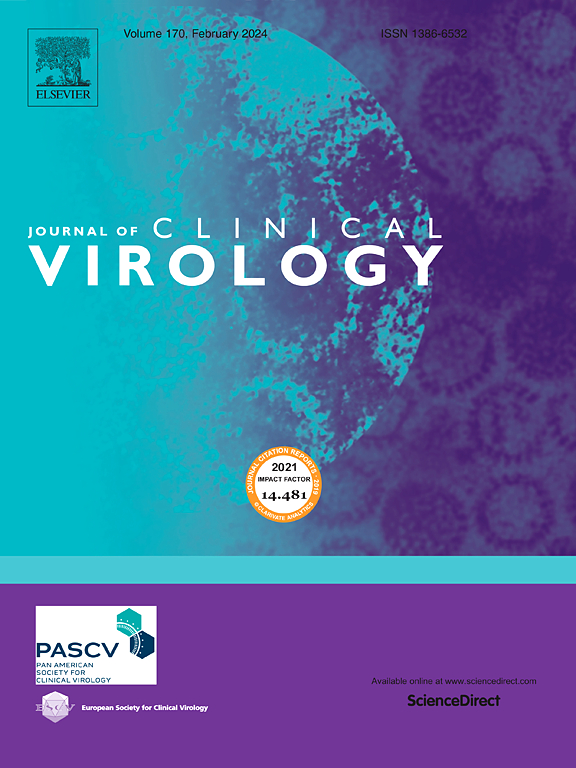血压指标和休克指标对住院成人登革热感染并发登革热危险的影响
IF 3.4
3区 医学
Q2 VIROLOGY
引用次数: 0
摘要
血压监测对于早期发现复杂登革热至关重要。我们在一个特征明确的登革热队列中调查了在登革热住院过程中血压指标与复杂登革热危险之间的关系。这项研究纳入了2005年至2008年期间住院的4789名成人登革热患者,这些患者最初没有并发登革热(定义为登革出血热和/或重症登革热)。病例(n = 689)包括住院期间进展为复杂登革热的患者,而对照组为未进展为复杂登革热的患者(n = 4100)。我们使用带有时间相关协变量的Cox模型来估计血压指标对复杂登革热危害影响的风险比。此外,我们采用重叠加权法来平衡临床特征,并根据年龄、性别和警告信号进行亚组分析。结果显示,在主要队列中,修正休克指数(MSI)≥0.8与较高的时间平均危险相关(HR: 1.72 [1.36, 2.19], p值:<;0.01)。休克指数(SI)≥0.7也表明主要队列(HR: 1.64 [1.37, 1.95], p值:<;0.01)和无粘膜出血患者(HR: 1.42 [1.19, 1.72], p值:<;0.01)的危险性增加。在主要队列中,舒张压(DBP)为60 mmHg会导致并发登革热的更高危险(HR: 1.45 [1.23, 1.72], p值:<;0.01)。综上所述,舒张压(DBP <60 mmHg)、休克指数≥0.7和修正休克指数≥0.8可能是成人登革热患者住院期间并发登革热的可靠预测因子。临床医生在评估患者时应考虑这些指标。本文章由计算机程序翻译,如有差异,请以英文原文为准。
The impact of blood pressure indicators and shock indices on hazard of complicated dengue in hospitalized adults with dengue infection
Blood pressure monitoring is crucial for early detection of complicated dengue. We investigated the association between blood pressure indicators and complicated dengue hazard over the course of dengue hospitalization in a well-characterized dengue cohort. This study involved 4789 adult dengue patients hospitalized between 2005 and 2008 who did not have complicated dengue (defined as dengue haemorrhagic fever and/or severe dengue) initially. Cases (n = 689) included patients who progressed to complicated dengue during hospitalization, while controls were patients who did not (n = 4100). We used Cox models with time-dependent covariates to estimate hazard ratios for blood pressure indicators' impact on complicated dengue hazard. Additionally, we employed the overlap weighting approach to balance clinical characteristics and conducted subgroup analyses based on age, sex and warning signs. Results indicated that modified shock index (MSI) 0.8 was associated with a higher time-averaged hazard in the main cohort (HR: 1.72 [1.36, 2.19], p-value: <0.01). Shock index (SI) ≥0.7 also indicated increased hazard in the main cohort (HR: 1.64 [1.37, 1.95], p-value: <0.01) and among patients without mucosal bleeding (HR: 1.42 [1.19, 1.72], p-value: <0.01). A DBP <60 mmHg led to higher hazards of complicated dengue (HR: 1.45 [1.23, 1.72], p-value: <0.01) in the main cohort. In conclusion, DBP <60 mmHg, shock index 0.7 and modified shock index 0.8 may be reliable predictors for complicated dengue during hospitalization in adult dengue patients. Clinicians should consider these indices during patient assessment.
求助全文
通过发布文献求助,成功后即可免费获取论文全文。
去求助
来源期刊

Journal of Clinical Virology
医学-病毒学
CiteScore
22.70
自引率
1.10%
发文量
149
审稿时长
24 days
期刊介绍:
The Journal of Clinical Virology, an esteemed international publication, serves as the official journal for both the Pan American Society for Clinical Virology and The European Society for Clinical Virology. Dedicated to advancing the understanding of human virology in clinical settings, the Journal of Clinical Virology focuses on disseminating research papers and reviews pertaining to the clinical aspects of virology. Its scope encompasses articles discussing diagnostic methodologies and virus-induced clinical conditions, with an emphasis on practicality and relevance to clinical practice.
The journal publishes on topics that include:
• new diagnostic technologies
• nucleic acid amplification and serologic testing
• targeted and metagenomic next-generation sequencing
• emerging pandemic viral threats
• respiratory viruses
• transplant viruses
• chronic viral infections
• cancer-associated viruses
• gastrointestinal viruses
• central nervous system viruses
• one health (excludes animal health)
 求助内容:
求助内容: 应助结果提醒方式:
应助结果提醒方式:


